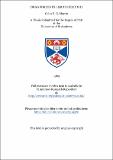Files in this item
Drag forces in liquid helium II
Item metadata
| dc.contributor.advisor | Osborne, D. V. | |
| dc.contributor.author | Martin, Colin N. B. | |
| dc.coverage.spatial | 150 p. | en_US |
| dc.date.accessioned | 2018-06-25T10:33:17Z | |
| dc.date.available | 2018-06-25T10:33:17Z | |
| dc.date.issued | 1969 | |
| dc.identifier.uri | https://hdl.handle.net/10023/14526 | |
| dc.description.abstract | Measurements of drag forces an spheres end a cylinder in open rectangular channels in liquid helium II heat flow and superflow wore mode at temperatures between 1.3°K and the λ-point. The drag forces were measured by the deflection of a torsion system suspended above the free surface of the liquid from a quarts fibre. In the heat flow experiments, the drag vas found to be similar to that which would be exerted by a classical fluid with the same velocity, viscosity and density as the norma1 component. Correlations of the drag coefficient D/( ½ ρ[sub]n²A) with the Reynolds numbers ρnᵛηᵈ/ηn and ρᵛnᵈ/ηn show that the former is much more suitable both in tor of eliminating temperature dependence and agreement with the classical value. Above 1.6°K, a small decrease in drag with increasing velocity was usually noticed; this was attributed to the onset of turbulence in the superfluid, giving rise to a component of drag in the direction of superfluid flow. Describing the turbulent superfluid so a laminarly flowing fluid with an effective viscosity ηs makes possible an ardor of magnitude estimate of ηs the decrease in drag; it is found to lie between 10 and 100 micropoise. At temperatures nearer the λ -point, the simple two fluid description appears to become lies adequate. In the superflow experiments, sphere an the cylinder arc dragged in the direction of the superfluid flow. Correlations of drag coefficient with Reynolds number suggest value for the effective viscosity of between 20 and 100 micropoise. In the cylinder superflow experiments, below a velocity of 2±1 am sec⁻¹, no drag was observable. This is attributed to an ideal flow regime and is bellowed to be the first direct demonstration of D'Alembert's wades, rely that an inviscid fluid can exert no drag on a body. | en_US |
| dc.language.iso | en | en_US |
| dc.publisher | University of St Andrews | |
| dc.subject.lcc | QC151.M2 | |
| dc.subject.lcsh | Fluid dynamics | en |
| dc.title | Drag forces in liquid helium II | en_US |
| dc.type | Thesis | en_US |
| dc.contributor.sponsor | Science Research Council (Great Britain) | en_US |
| dc.type.qualificationlevel | Doctoral | en_US |
| dc.type.qualificationname | PhD Doctor of Philosophy | en_US |
| dc.publisher.institution | The University of St Andrews | en_US |
This item appears in the following Collection(s)
Items in the St Andrews Research Repository are protected by copyright, with all rights reserved, unless otherwise indicated.

